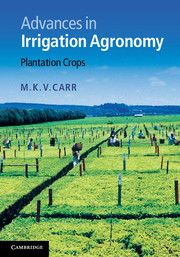10 - Tea
Published online by Cambridge University Press: 05 May 2012
Summary
Introduction
Tea (Camellia sinensis L.) is believed to have originated within the fan-shaped area extending from the Assam/Burma border in the west to China in the east (c. 26° N), and south from this line through Burma and Thailand to Vietnam (c. 14° N) (Kingdom-Ward, 1950; Mair and Hoh, 2009). This is an area of monsoon climates with a warm, wet summer and a cool, dry (or less wet) winter. From the main centres of cultivation in South-east Asia tea has been introduced into many other areas of the world and is now grown in conditions that range from Mediterranean-type climates to the hot, humid tropics, from Georgia in the north (42° N) to Argentina (27° S) and New Zealand (37° S) in the south, and from sea level to 2700 m altitude (Carr, 1972). By far the largest producer of tea is China (estimated planted area by 2008 = 1.4 million ha; annual production of processed tea = 1.3 million t) followed by India (474 000 ha; 800 000 t) and then Kenya (158 000 ha; 345 000 t) and Sri Lanka (222 000 ha; 319 000 t) (FAO, 2010b).
In this chapter, the contribution of research into the water relations and irrigation requirements of tea over the last 40 years to commercial crop management, and to our understanding of the physiology of the crop, is summarised and reviewed. The focus is on work done in eastern Africa where the Tea Research Foundation of Kenya (TRFK; 0° 22c′ S; alt. 2200 m), the Tea Research Institute of Tanzania (TRIT, 8° 32′ S; alt. 1840 m), and the Tea Research Foundation of Central Africa (TRFCA, 16° 05′ S; alt. 630 m), based in Malawi, have all undertaken fundamental research on these topics. Prior to 1978, the Tea Research Institute of East Africa (TRIEA) served three countries – Kenya, Tanzania and Uganda. Some of the major private tea companies also undertake their own research.
- Type
- Chapter
- Information
- Advances in Irrigation AgronomyPlantation Crops, pp. 222 - 274Publisher: Cambridge University PressPrint publication year: 2012



